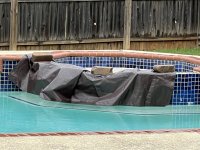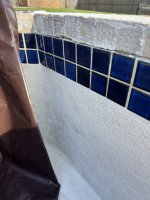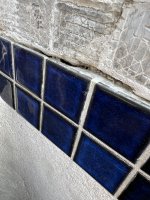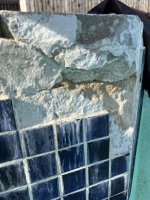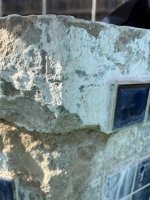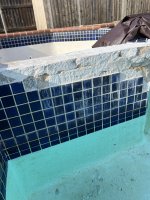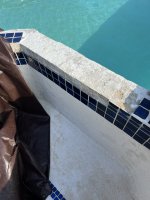This past winter’s storms and near-zero freezes damaged the “wall” around my outdoor pool’s spa. Initially I thought that I just needed to re-attach and re/grout the spa tiles using Leslie’s Patch-It, but as I removed tile after tile I noticed that a small amount of the “substrate” beneath some of the tiles is damaged. By substrate, I’m referring to the structure beneath the tiles - which appears to be concrete.
There are several spots where the “concrete” beneath the tiles is cracked, and several 1/2” chunks simply fell out.
I’m not in financial position to pay big $$ for an expert’s repair.
Can I use concrete to fill the damaged areas and cracks, then allow that to cure, and then proceed to use Patch-It to secure the tiles? If so, is there a specific product recommended?
I have no experience with this specific type of repair; however, I did build my own pool equipment pad several years ago, using rock, rebar, etc, which has held up 100% for several years, but this damaged spa wall needs a very smooth surface on which to re-seat tiles.
I’m looking for professional-quality answers: what specific material would be best to repair/replace the damaged area beneath the tiles.
Thanks in advance!
I covered the damaged area with a tarp, so closeup pics are not currently available as it is raining hard today in Texas. Included one pic, but can provide more after things dry up over the next few days.
I appreciate your help!
John in DFW
There are several spots where the “concrete” beneath the tiles is cracked, and several 1/2” chunks simply fell out.
I’m not in financial position to pay big $$ for an expert’s repair.
Can I use concrete to fill the damaged areas and cracks, then allow that to cure, and then proceed to use Patch-It to secure the tiles? If so, is there a specific product recommended?
I have no experience with this specific type of repair; however, I did build my own pool equipment pad several years ago, using rock, rebar, etc, which has held up 100% for several years, but this damaged spa wall needs a very smooth surface on which to re-seat tiles.
I’m looking for professional-quality answers: what specific material would be best to repair/replace the damaged area beneath the tiles.
Thanks in advance!
I covered the damaged area with a tarp, so closeup pics are not currently available as it is raining hard today in Texas. Included one pic, but can provide more after things dry up over the next few days.
I appreciate your help!
John in DFW


